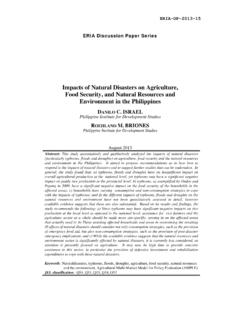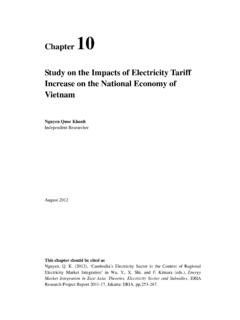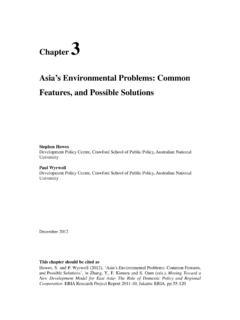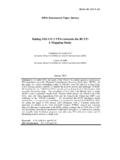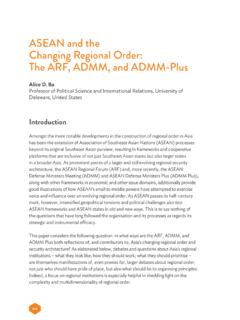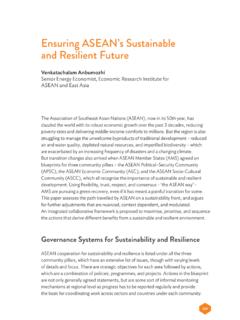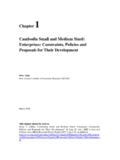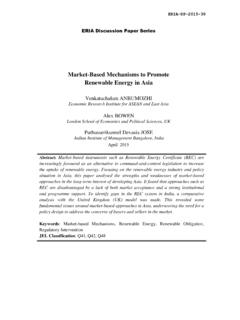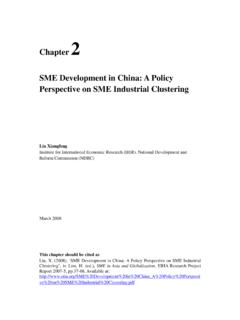Transcription of Brunei Darussalam Country Report - ERIA: Economic …
1 Chapter 3 Brunei Darussalam Country Report September 2016 This chapter should be cited as Energy and Industry Department of Prime Minister s office (2016), Brunei Darussalam Country Report , in Kimura,S. and (eds.) in Energy Outlook and Energy Saving Potential in East Asia 2016. ERIA Research Project Report 2015-5, Jakarta: ERIA, C h a p t e r 3 Brunei Darussalam Country Report ENERGY AND INDUSTRY DEPARTMENT, PRIME MINISTER S OFFICE, Brunei Darussalam 1. Background runei Darussalam is located on the north-west coast of Borneo Island in Southeast Asia. The Country s proximity to the South China Sea provides it with access to one of the important trade corridors in the world.
2 The total area of Brunei is 5,765 square kilometres and the Country is divided into four administrative districts, namely Brunei Muara, Belait, Tutong, and Temburong. Its capital city is Bandar Seri Begawan, located in the Brunei Muara District. Brunei is an economy with great Economic potential. Its gross domestic product (GDP) in 2013 was around US$10 billion at 2005 constant prices. With a population of 406,200, Brunei s GDP per capita was almost US$25,000 at 2005 constant prices. About 60 percent of Brunei s GDP is generated by the energy sector, reflecting the huge contribution of this sector to the Country s economy. The energy sector also dominates the Country s export values, with crude oil, liquefied natural gas (LNG), and methanol exports accounting for over 90 percent of its total exports.
3 The main export destinations for these commodities are India (crude oil), Japan (LNG), and China (methanol). To lead Brunei s economy into a sustainable future, Brunei s Energy White Paper (EWP), launched in March 2014, set-out three strategic goals. Strategic Goal 1 is B 80 Energy Outlook and Energy Saving Potential in East Asia to strengthen and to grow oil and gas upstream and downstream activities; Strategic Goal 2 is to ensure safe, secure, reliable, and efficient supply and use of energy; and Strategic Goal 3 is to maximise Economic spin-off from the energy industry. 2. Energy Supply and Consumption in 2013 Oil and natural gas remain the main primary sources of energy for Brunei .
4 In 2013, total primary energy supply (TPES) for both energy sources was Mtoe, with Mtoe or percent for domestic gas consumption. The 2013 TPES was Mtoe lower than in 2012, mainly due to a drop in oil and natural gas production in 2013. As an oil and LNG exporter, Brunei exported percent of its oil and natural gas (as LNG) produced in 2013. Public utilities in Brunei have an installed power generation capacity of MW including solar photovoltaic at MW. Electricity production by the public utilities was TWh in 2013. In the same year, installed capacity of auto producers was MW; they produced TWh of electricity, an increase of TWh from 2012, which is related to an increase of electricity demand from the oil and gas industry.
5 Brunei s total final energy consumption (TFEC) in 2013 amounted to Mtoe, a decrease of Mtoe from 2012, mainly due to a decline in final energy consumption in the industrial sector from Mtoe in 2012 to Mtoe in 2013. The transport sector was the highest energy user in 2013, at Mtoe or percent of the TFEC. This was followed by the others sector (Commercial and Residential) at Mtoe ( percent), the Industrial Sector at Mtoe ( percent), and Non-Energy use at Mtoe ( percent). In terms of energy sources, oil products consumption consisted mainly of gasoline, diesel, kerosene, and LPG at Mtoe, which accounted for percent of final energy consumption.
6 This was followed by electricity at Mtoe ( percent) and town gas at Mtoe ( percent). 81 Brunei Darussalam Country Report Table 3-1. Energy Supply and Consumption 2013 (Mtoe) Supply and Consumption Oil Gas Electricity Total Primary Energy Supplies Indigenous Production - Net Import and Others - Total Primary Energy Supply - Final Energy Consumption Industrial Sector - Transport Sector - - Others Sector1 Non-Energy - - Total Final Energy Consumption Mtoe = million tons of oil equivalent. Note: Heating Values conversion factor of for natural gas: 1 TJ = Ktoe is based on IEA conversion factors.
7 Source: IEA and IEEJ, 2016. 3. Energy Policies Supply Brunei has an aspiration to boost upstream production by maximising the potential of its matured fields and venturing into further exploration and development activities. On the exploration side, in order to ensure the sustainability of crude oil and natural gas production in the Country , an increase in the seismic data acquisition activities in Brunei over the last few years has contributed to a high number of exploration successes. In addition, other upstream projects such as secondary and tertiary recovery from existing fields 1 Others sector includes Residential and Commercial.
8 82 Energy Outlook and Energy Saving Potential in East Asia have been implemented to increase the recovery from these matured fields and increase in the Country s reserve as well as improve the productivity of Brunei s production. However, the Country s crude oil and natural gas production in 2013 declined to 372 KBOE per day from 403 KBOE per day in 2012 due to continuous efforts in maintenance activities to address asset integrity issues. The positive impact from asset maintenance activities should become apparent in the coming years In line with the national vision set out in Wawasan Brunei 2035, Brunei is working further in downstream by maximising the added value creation potential from upstream production and assets.
9 In addition to the Methanol plant, which has been in operation since 2010, preparation for several downstream projects such as export oriented refinery and gas petrochemical projects has progressed. These are expected to be commercially on-stream by 2019. As for renewable energy, Brunei targets to increase its share of the power generation mix from renewable energy to at least 10 percent by 2035. Brunei has started to develop renewable energy resources, particularly solar photovoltaic (PV) and waste-to-energy which are deemed feasible at this stage. To support the development of renewable energy sources, the government plans to introduce renewable energy policy and regulatory frameworks that will stimulate investment both by the government and the private sector in developing and deploying renewable energy.
10 Consumption Brunei has made much progress in terms of improving energy efficiency and conservation (EEC) with its aims of a 45 percent energy intensity reduction by 2035. In achieving the energy intensity target, relevant government agencies and industry have been collaborating to draw up the appropriate legislation and to introduce financial and fiscal policy measures that promote energy efficiency and low-energy intensive industries. 83 Brunei Darussalam Country Report One initiative was electricity tariff reform, which was implemented on 1 January 2012. The main objective of this reform is to move from a regressive to a progressive tariff structure.
